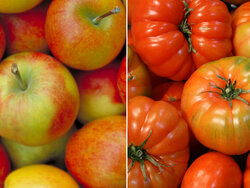Facts & Figures
Organic farming in figures
Heike Kuhnert | 28.08.2025
How many farms are organic in Germany? Which federal states are in the lead in terms of the proportion of organically farmed land, and which are behind? And how does Germany compare with the rest of the EU?
According to official data, at the end of 2024, 35,881 farms in Germany were operating according to organic farming standards, on a total of about 1.99 million hectares. The share of organically farmed land in the total agricultural area comes up to 11,5 percent, and the share of organic farms in all farms is 14,1 percent (BMLEH 2025). Compared to the previous year the number of organic farms has fallen slightly (-799 farms) – for the second time in a row in the last 31 years. At 24,213 hectares, the increase in organically farmed land in Germany is in the bottom quarter of the figures recorded in this period. Compared to the previous year, the increase in area is 1.3 per cent.
From very small to very large
The average organic farm manages about 53 hectares, however there is a very wide range within the organic farms. The group of organic farms includes farms with special crops such as wine on a few hectares of arable land or farms with suckler cows on over 1,000 hectares. The latter are mainly at home in the eastern federal states of Brandenburg and Mecklenburg-Western Pomerania on rather sparse sites dominated by grassland.
The importance of organic farming varies from region to region
The importance of organic farming varies considerably from region to region. In 2024, the relative share of land ranged from more than 21 percent in the small Saarland, nearly 18 percent in Brandenburg to about 6 percent in Lower Saxony. In absolute terms, the focus of organic farming is in southern and north-eastern Germany: in 2024, 429,662 hectares in Bavaria and 212,745 hectares in Baden-Württemberg were farmed organically; in Brandenburg the organic area comes up to 228,852 hectares and in Mecklenburg-Western Pomerania to 207,795 hectares (BMLEH 2025). These four federal states account for more than half (57 percent) of the organically farmed area in Germany.
Reasons for regional differences
Organically farmed areas are mainly located in Bavaria and Baden-Württemberg, followed by Brandenburg and Mecklenburg-Western Pomerania. In these states in particular, but also nationwide, organic farming is practiced primarily on lower-yielding sites with a high proportion of permanent grassland. Land rents tend to be low there and extensive farming is relatively common. These conditions facilitate conversion to organic farming, which avoids the use of mineral fertilizers and chemical pesticides. The yield reductions and economic losses associated with conversion to organic farming are therefore comparatively lower than for intensively managed farms on high-yield sites.
Interesting insights into the regional situation of organic farming in Germany are provided by the contributions of Alvermann and Timm: Ökolandbau regional – Bio2030 Mitmach-Tagungen. (only in German)
Organic farming in the EU
According to Eurostat (2024), the total organic area in the EU in 2022 was 16.9 million hectares. This corresponds to a share of nearly 11 percent of the total agricultural area of the 27 EU countries. Germany is in the middle of the EU countries in terms of organic area-share. With over 25 percent, Austria has the highest proportion of organically farmed land, followed by Estonia and Sweden, Portugal and Italy.
Read more about the development of organic farming
- Organic Farming in Germany - Information of the BMLEH (in German)
- Zahlen, Daten, Fakten des BÖLW (in German)
- The World of Organic Agriculture, FiBL
- FiBL Statistics
- Ergebnisse der Agrarstrukturerhebung zum Ökolandbau 2020 (in German)
- Destatis Agrarstrukturerhebung 2020 ÖL (in German)
- Eurostat Organic Farming Statistics







